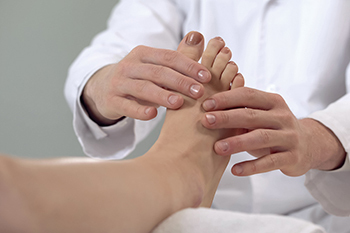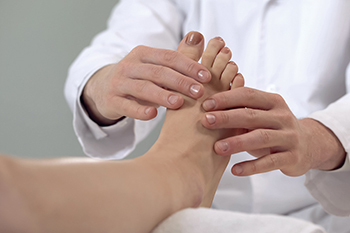Connect With Us
Blog
Items filtered by date: September 2022
Foot Ulcers and Diabetic Patients

A common foot condition among diabetic patients is a foot ulcer. Foot ulcers often occur from the inability to feel existing cuts, bruises, or scrapes which can be a result of neuropathy. Therefore, it is imperative to check the soles daily. Additionally, engaging in a gentle exercise routine may be beneficial in increasing circulation to the feet. A diabetic foot ulcer generally requires immediate medical care, and this may help to prevent an impending infection that could ultimately lead to amputation when left untreated. A diabetic foot ulcer can cause severe pain and discomfort, and it is suggested to refrain from putting any weight on the affected foot. Some people choose to wear shoes that are designed specifically for diabetic patients as well as compression wraps that help to improve circulation. If you have diabetes, it is strongly suggested that you are under the care of a podiatrist who can effectively treat and help you to manage this condition.
Diabetic foot care is important in preventing foot ailments such as ulcers. If you are suffering from diabetes or have any other concerns about your feet, contact Michael Tomey, DPM from Cary Foot & Ankle Specialists. Our doctor can provide the care you need to keep you pain-free and on your feet.
Diabetic Foot Care
Diabetes affects millions of people every year. The condition can damage blood vessels in many parts of the body, especially the feet. Because of this, taking care of your feet is essential if you have diabetes, and having a podiatrist help monitor your foot health is highly recommended.
The Importance of Caring for Your Feet
- Routinely inspect your feet for bruises or sores.
- Wear socks that fit your feet comfortably.
- Wear comfortable shoes that provide adequate support.
Patients with diabetes should have their doctor monitor their blood levels, as blood sugar levels play such a huge role in diabetic care. Monitoring these levels on a regular basis is highly advised.
It is always best to inform your healthcare professional of any concerns you may have regarding your feet, especially for diabetic patients. Early treatment and routine foot examinations are keys to maintaining proper health, especially because severe complications can arise if proper treatment is not applied.
If you have any questions please feel free to contact our office located in Cary, NC . We offer the newest diagnostic and treatment technologies for all your foot and ankle needs.
All About the Metatarsal Bones

Although you may not always think about it, there are many different bones in your feet that play important roles and are constantly supporting your every movement. The metatarsal bones are one example of critical bones that are located in the feet. There are five metatarsals that comprise the arches of your feet. This makes them play an important role in bearing and supporting weight. The 1st metatarsal bone is the thickest bone, and consequently, it bears more weight than the other metatarsals. It is important to note that although fractures are rare, an individual can fracture the metatarsals when large objects that are heavy fall on them. Hallux Valgus, or bunions, is also a condition that can negatively impact the 1st metatarsal. If you want to learn more about the metatarsal bones, or are concerned about your metatarsals, contact a podiatrist today.
If you have any concerns about your feet, contact Michael Tomey, DPM from Cary Foot & Ankle Specialists. Our doctor can provide the care you need to keep you pain-free and on your feet.
Biomechanics in Podiatry
Podiatric biomechanics is a particular sector of specialty podiatry with licensed practitioners who are trained to diagnose and treat conditions affecting the foot, ankle and lower leg. Biomechanics deals with the forces that act against the body, causing an interference with the biological structures. It focuses on the movement of the ankle, the foot and the forces that interact with them.
A History of Biomechanics
- Biomechanics dates back to the BC era in Egypt where evidence of professional foot care has been recorded.
- In 1974, biomechanics gained a higher profile from the studies of Merton Root, who claimed that by changing or controlling the forces between the ankle and the foot, corrections or conditions could be implemented to gain strength and coordination in the area.
Modern technological improvements are based on past theories and therapeutic processes that provide a better understanding of podiatric concepts for biomechanics. Computers can provide accurate information about the forces and patterns of the feet and lower legs.
Understanding biomechanics of the feet can help improve and eliminate pain, stopping further stress to the foot.
If you have any questions please feel free to contact our office located in Cary, NC . We offer the newest diagnostic and treatment technologies for all your foot and ankle needs.
Why Live with Pain and Numbness in Your Feet?
Facts About Bunions

A bunion, medically known as hallux valgus, occurs when the base of the big toe bone moves outward, pushing the rest of the toe inward. A bunion can cause the foot to become wider, and make it difficult to find shoes that fit. It often rubs against the inside of the toe box and becomes red and irritated. Although wearing shoes that are too small, especially during one’s formative years, is not ideal, it is believed that genetics play a major role in the development of a bunion. Most people with bunions can find some relief through non-surgical means, including pain relief medication. In addition, finding wider shoes with a lower heel, and avoiding high heels, or shoes that are excessively pointy, can help. Losing weight may also reduce the pressure on the big toe. In severe cases, surgery is an option that can help correct the alignment of the toes. If a bunion is causing pain on a regular basis, it is a good idea to consult a podiatrist who can assess the situation and suggest a treatment plan.
If you are suffering from bunion pain, contact Michael Tomey, DPM of Cary Foot & Ankle Specialists. Our doctor can provide the care you need to keep you pain-free and on your feet.
What Is a Bunion?
Bunions are painful bony bumps that usually develop on the inside of the foot at the joint of the big toe. As the deformity increases over time, it may become painful to walk and wear shoes. Women are more likely to exacerbate existing bunions since they often wear tight, narrow shoes that shift their toes together. Bunion pain can be relieved by wearing wider shoes with enough room for the toes.
Causes
- Genetics – some people inherit feet that are more prone to bunion development
- Inflammatory Conditions - rheumatoid arthritis and polio may cause bunion development
Symptoms
- Redness and inflammation
- Pain and tenderness
- Callus or corns on the bump
- Restricted motion in the big toe
In order to diagnose your bunion, your podiatrist may ask about your medical history, symptoms, and general health. Your doctor might also order an x-ray to take a closer look at your feet. Nonsurgical treatment options include orthotics, padding, icing, changes in footwear, and medication. If nonsurgical treatments don’t alleviate your bunion pain, surgery may be necessary.
If you have any questions, please feel free to contact our office located in Cary, NC . We offer the newest diagnostic and treatment technologies for all your foot care needs.
What to Consider When Children’s Shoes Are Purchased

The coronavirus brought times to the world where children were homeschooled, and time was limited for physical activities because of threatening germs. The type of shoes children wore were often overlooked as shoe stores were closed and new shoes were rarely purchased. As current times are upon us and children have returned to school, the first step in choosing the correct shoes for your child generally starts with getting the right shoe size. This is done by properly measuring the foot using a Brannock device, which is found in most shoe stores. The type of shoe that is desired is often considered, in addition to the material that it is made from, if they are lightweight, and have protection and flexibility. And lastly, the shoes need to fit comfortably from the moment they are tried on and should not need a break in period. Children that live in various climates and environments typically will wear different types of shoes and how long the shoes are worn is often considered. If you have questions about what type of shoes your children should wear, please schedule an appointment with a podiatrist.
The health of a child’s feet is vital to their overall well-being. If you have any questions regarding foot health, contact Michael Tomey, DPM of Cary Foot & Ankle Specialists. Our doctor can provide the care you need to keep you pain-free and on your feet.
Tips for Keeping Children's Feet Healthy
- Make sure their shoes fit properly
- Look for any signs of in-toeing or out-toeing
- Check to see if they have Clubfoot (condition that affects your child’s foot and ankle, twisting the heel and toes inward) which is one of the most common nonmajor birth defects.
- Lightly cover your baby’s feet (Tight covers may keep your baby from moving their feet freely, and could prevent normal development)
- Allow your toddler to go shoeless (Shoes can be restricting for a young child’s foot)
- Cut toenails straight across to avoid ingrown toenails
- Keep your child’s foot clean and dry
- Cover cuts and scrapes. Wash any scratches with soap and water and cover them with a bandage until they’ve healed.
If you have any questions, please feel free to contact our office located in Cary, NC . We offer the newest diagnostic and treatment technologies for all your foot care needs.

